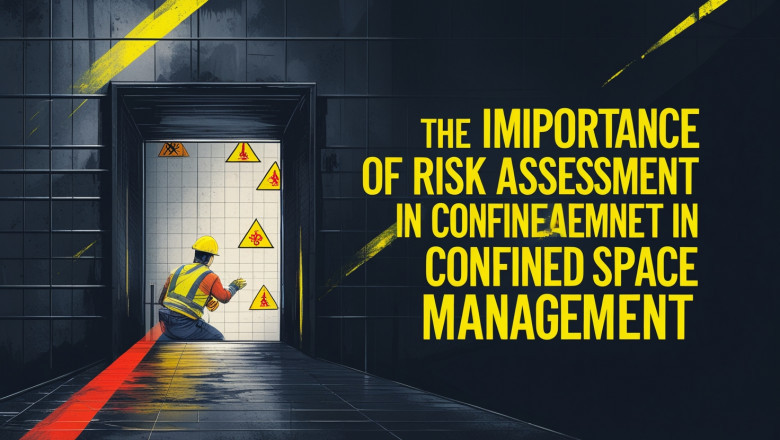views
The Importance of Risk Assessment in Confined Space Management
Confined spaces are some of the most hazardous environments encountered in industrial, construction, and maintenance operations. These spaces are not designed for continuous occupancy and often present unique risks that can quickly become life-threatening if not properly managed. Whether it’s a tank, vessel, silo, manhole, or pipeline, confined spaces demand a comprehensive approach to safety.
Among all the safety measures employed in confined space operations, risk assessment stands out as the most critical. A thorough risk assessment not only helps in identifying the potential hazards within a confined space but also serves as the foundation for implementing appropriate control measures. In this blog, we’ll delve into the importance of risk assessment in confined space management, its core components, and how it contributes to worker safety and compliance.
Understanding Confined Spaces
Before diving into risk assessments, it’s important to define what constitutes a confined space. According to safety regulations in many jurisdictions, a confined space has the following characteristics:
-
It is not designed for continuous human occupancy.
-
It has limited means of entry or exit.
-
It is large enough for a worker to enter and perform assigned tasks.
Confined spaces can also be classified as:
-
Permit-required confined spaces (PRCS): These contain or have the potential to contain hazardous conditions.
-
Non-permit confined spaces: These do not contain hazards capable of causing death or serious physical harm.
Even in non-permit spaces, unexpected dangers can arise, which is why risk assessment remains universally essential.
Why Risk Assessment is Crucial in Confined Space Management
1. Identifying Hazards
The foremost goal of a risk assessment is to identify potential hazards. Confined spaces can harbor numerous dangers such as:
-
Oxygen deficiency or enrichment
-
Toxic gas accumulation
-
Flammable or explosive atmospheres
-
Engulfment by liquids or loose materials
-
Mechanical and electrical hazards
-
Poor visibility and limited mobility
Early identification of these hazards allows safety teams to tailor their protective strategies and equipment accordingly.
2. Preventing Accidents and Fatalities
Confined space incidents are often catastrophic due to the environment’s unforgiving nature. A risk assessment ensures:
-
Entry is only attempted when it is absolutely safe.
-
Necessary precautions are taken to mitigate risks.
-
Emergency plans are in place in case something goes wrong.
In essence, risk assessments save lives.
3. Legal and Regulatory Compliance
Occupational health and safety authorities—like OSHA in the U.S. or Safe Work Australia—mandate comprehensive risk assessments before entering confined spaces. Non-compliance can lead to:
-
Heavy fines
-
Legal liabilities
-
Shutdown of operations
-
Reputational damage
A well-documented risk assessment ensures organizations meet all regulatory requirements and are prepared for audits and inspections.
4. Developing Effective Safety Protocols
Risk assessment is the first step toward creating effective confined space entry procedures. Based on the identified hazards, safety managers can determine:
-
Required personal protective equipment (PPE)
-
Gas detection and ventilation needs
-
Communication systems
-
Rescue and emergency procedures
-
Permit-to-work systems
Without risk assessment, these protocols may be incomplete or ineffective.
5. Enabling Proper Training and Awareness
Workers entering confined spaces need to be trained based on specific risks. A generic safety briefing won’t suffice. A detailed risk assessment allows for:
-
Tailored training sessions
-
Scenario-based simulations
-
Increased situational awareness among employees
The result is a workforce that’s both competent and confident in managing confined space risks.
Key Components of a Confined Space Risk Assessment
A comprehensive confined space risk assessment generally includes the following components:
1. Initial Site Evaluation
-
Identification of confined spaces
-
Classification into permit-required or non-permit
-
Recording of location, structure, and access points
2. Hazard Identification
-
Atmospheric testing (O₂ levels, toxic gases, flammables)
-
Structural integrity assessment
-
Mechanical and electrical hazards
-
Biological risks (e.g., mold, bacteria)
-
Environmental concerns (e.g., water ingress)
3. Risk Analysis and Evaluation
-
Likelihood and severity of each identified hazard
-
Possible consequences and exposure scenarios
-
Prioritization of risks using risk matrices
4. Control Measures Implementation
-
Engineering controls (ventilation, isolation of energy sources)
-
Administrative controls (safe work procedures, permits)
-
PPE requirements (respirators, harnesses, helmets)
5. Emergency and Rescue Planning
-
Identification of potential emergencies
-
Designated rescue team and equipment
-
Rescue plan tailored to the specific space
6. Documentation and Review
-
Detailed risk assessment report
-
Confined space entry permit
-
Regular review and update of assessment
Common Hazards and Risk Control Strategies
Let’s look at common confined space hazards and how risk assessments help in managing them:
Risk assessments offer the clarity needed to select the right combination of controls to mitigate these hazards.
Risk Assessment and the Permit-to-Work System
The permit-to-work system is closely tied to risk assessments. Before a permit is issued for confined space entry, a full risk assessment must be conducted and documented.
The permit confirms:
-
The space has been tested and cleared
-
Control measures are in place
-
Workers are trained and authorized
-
Emergency systems are active and accessible
Without an accurate risk assessment, permits would be issued on assumptions, exposing workers to unacceptable risks.
The Role of Technology in Risk Assessment
Modern confined space management benefits greatly from advancements in technology:
1. Gas Detection Equipment
Real-time, multi-gas monitors improve h













Comments
0 comment